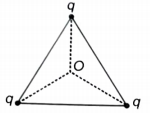A spherical capacitor has an inner sphere of radius \(12\) cm and an outer sphere of radius \(13\) cm. The outer sphere is earthed and the inner sphere is given a charge of \(2.5\) C. The space between the concentric spheres is filled with a liquid of dielectric constant \(32.\) The capacitance of the capacitor is:
1. \(4.0\times 10^{-9}\) F
2. \(4.5\times 10^{-9}\) F
3. \(5.5\times 10^{-9}\) F
4. \(3.3\times 10^{-9}\) F
1. \(4.0\times 10^{-9}\) F
2. \(4.5\times 10^{-9}\) F
3. \(5.5\times 10^{-9}\) F
4. \(3.3\times 10^{-9}\) F
A cylindrical capacitor has two co-axial cylinders of length \(15~\text{cm}\) and radii \(1.5~\text{cm}\) and \(1.4~\text{cm}\). The outer cylinder is earthed and the inner cylinder is given a charge of \(3.5~\mu \text{C}\). The capacitance of the system is:
1. \(3.4 \times10^{-10}~\text{F}\)
2. \(1.2 \times10^{-10}~\text{F}\)
3. \(4.8 \times10^{-9}~\text{F}\)
4. \(2.5 \times10^{-9}~\text{F}\)
A parallel plate capacitor is to be designed with a voltage rating of \(1 ~\text{kV},\) using a material of dielectric constant \(3\) and dielectric strength of about \(10^7 ~\text{V m}^{-1}.\) For safety, we should like the field never to exceed, say \(10\%\) of the dielectric strength. What minimum area of the plates is required to have a capacitance of \(50~\text{pF}?\)
1. \(19~\text{cm}^2\)
2. \(17~\text{cm}^2\)
3. \(15~\text{cm}^2\)
4. \(23~\text{cm}^2\)
In a Van-de-Graff type generator, a spherical metal shell is to be a \(15 \times 10^6 ~\text {V}\) electrode. The dielectric strength of the gas surrounding the electrode is \(5 \times 10^7 ~\text {V/m}.\) What is the minimum radius of the spherical shell required?
1. \(20~\text{cm}\)
2. \(30~\text{cm}\)
3. \(25~\text{cm}\)
4. \(35~\text{cm}\)
Three isolated equal charges are placed at the three corners of an equilateral triangle as shown in the figure. The statement which is true for net electric potential V and net electric field intensity E at the centre of the triangle is:

1.
2.
3.
4.
The potential at a point 0.1 m from an isolated point charge is +100 volt. The nature of the point charge is:
1. Positive
2. Negative
3. Zero
4. Either positive or zero
A charge of 10C is placed at the origin of the x-y coordinate system. The potential difference between two points (0, a) and (a, 0) in volt will be:
1.
2.
3.
4. Zero
Four charges of the same magnitude q are placed at four corners of a square of side a. The value of the electric potential at the centre of the square will be: (Where )
1.
2.
3.
4.
Two identical positive charges are placed on the y-axis at y=-a and y=+a. The variation of V (the electric potential) along the x-axis is shown by the graph:
1.
2.
3.
4.
Which graph best represents the variation of electric potential as a function of distance from the centre of a uniformly charged solid sphere of radius R?
1.
2.
3.
4.














